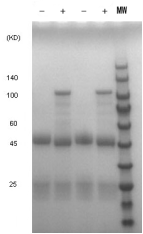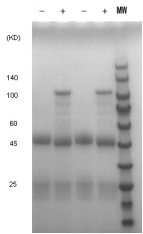BspQI限制性内切酶GMP级(II型限制性内切酶)(10 U/μL)
产品说明书
FAQ
COA
已发表文献
This product is a type II restriction endonuclease derived from the recombinant protein encoded by the BspQI gene in Bacillus sphaericus expressed by E.coli. Its recognition sequence is 5'-GCTCTTCN1/N4-3'. Use to digest plasmids to prepare poly(A/T/G/C)-terminated linearized DNA fragments to obtain specific cohesive ends.
This product is produced in accordance with GMP process requirements and provided in a liquid form.
Product Properties
|
Source |
Recombinant E. coli with BspQI gene |
|
Reaction Temperature |
50℃ |
|
Storage Conditions |
20 mM Tris-HCl, 0.5 M KCl, 0.1 mM EDTA, 1mM DTT, 0.1% Triton X-100, 50% Glycerol |
|
Unit Definition |
1 unit: The amount of enzyme required to digest 1 μg of λDNA within 1 h at 50℃ in a 50 μL system |
Contents
|
Contents No. |
Name |
Catalog No./Specification |
|||
|
10664ES76 (500 U) |
10664ES86 (2500 U) |
10664ES92 (10 KU) |
10664ES98 (100KU) |
||
|
10664 |
BspQI GMP-grade (10 U/μL) |
50 μL |
250 μL |
1 mL |
10 mL |
Shipping and Storage
The product is shipped with dry ice and can be stored at -15℃ ~ -25℃ for one year.
Applications
1. Digest the plasmid to prepare a linearized DNA fragment at the end of Poly (A/T/C/G);
2. Digestion of DNA to obtain specific sticky ends.
Experimental methods
50 μL reaction system
This step is suitable for linearization of 1 μg DNA (≥100 nt) and can be scaled up according to experimental needs.
1)Add the following components in sequence:
|
Components |
Volume |
|
Plasmid DNA |
1-2 μg |
|
10×Digestion Buffer 3 |
5.0 μL |
|
BspQI (10 U/μL) |
1.0 μL |
|
RNase-free ddH2O |
Up to 50 μL |
Note: 10× Digestion Buffer 3(Cat#10667): 500mM Tris-HCl, 1M NaCl,100mM MgCl2, 1mg/mL OsrHSA, pH7.9@25℃
2)Incubate at 50°C 1 h;
3)DNA linearization is complete, and subsequent experiments can be performed.
Notes:
1. The volume of restriction endonuclease added should not exceed 1/10 of the reaction volume;
2. For your safety and health, please wear personal protective equipment (PPE), such as laboratory coats and disposable gloves, when operating with this product.
HB220701
This product is a type II restriction endonuclease derived from the recombinant protein encoded by the BspQI gene in Bacillus sphaericus expressed by E.coli. Its recognition sequence is 5'-GCTCTTCN1/N4-3'. Use to digest plasmids to prepare poly(A/T/G/C)-terminated linearized DNA fragments to obtain specific cohesive ends.
This product is produced in accordance with GMP process requirements and provided in a liquid form.
Product Properties
|
Source |
Recombinant E. coli with BspQI gene |
|
Reaction Temperature |
50℃ |
|
Storage Conditions |
20 mM Tris-HCl, 0.5 M KCl, 0.1 mM EDTA, 1mM DTT, 0.1% Triton X-100, 50% Glycerol |
|
Unit Definition |
1 unit: The amount of enzyme required to digest 1 μg of λDNA within 1 h at 50℃ in a 50 μL system |
Contents
|
Contents No. |
Name |
Catalog No./Specification |
|||
|
10664ES76 (500 U) |
10664ES86 (2500 U) |
10664ES92 (10 KU) |
10664ES98 (100KU) |
||
|
10664 |
BspQI GMP-grade (10 U/μL) |
50 μL |
250 μL |
1 mL |
10 mL |
Shipping and Storage
The product is shipped with dry ice and can be stored at -15℃ ~ -25℃ for one year.
Applications
1. Digest the plasmid to prepare a linearized DNA fragment at the end of Poly (A/T/C/G);
2. Digestion of DNA to obtain specific sticky ends.
Experimental methods
50 μL reaction system
This step is suitable for linearization of 1 μg DNA (≥100 nt) and can be scaled up according to experimental needs.
1)Add the following components in sequence:
|
Components |
Volume |
|
Plasmid DNA |
1-2 μg |
|
10×Digestion Buffer 3 |
5.0 μL |
|
BspQI (10 U/μL) |
1.0 μL |
|
RNase-free ddH2O |
Up to 50 μL |
Note: 10× Digestion Buffer 3(Cat#10667): 500mM Tris-HCl, 1M NaCl,100mM MgCl2, 1mg/mL OsrHSA, pH7.9@25℃
2)Incubate at 50°C 1 h;
3)DNA linearization is complete, and subsequent experiments can be performed.
Notes:
1. The volume of restriction endonuclease added should not exceed 1/10 of the reaction volume;
2. For your safety and health, please wear personal protective equipment (PPE), such as laboratory coats and disposable gloves, when operating with this product.
HB220701
Q: 模板线性化的酶切位点大多采用BspQI,bsaI,主要是因为什么原因呢?我看它们都属于IIS型限制性内切酶,这个具体有什么影响吗?
A: mRNA体外转录模板制备方面,限制性内切酶的选择主要基于以下因素:
①切口处应该是5´ 突出末端或者平末端。3´ 突出末端的存在会增加从模板体外转录(IVT)产生的假副产物;
②酶切位点识别序列尽可能长;识别序列越长,该序列出现在基因片段中的可能性就越小;
③IIS 型内切酶是用于疫苗开发中质粒线性化的首选酶,因为它们的切割位点在识别序列之外,可以确保所设计的 poly(A) 尾的完整性。使用 IIS 型内切酶线性化后的 DNA 模板上不会留下“疤痕”,IVT 过程中也不会添加不需要的核苷酸。
④内切酶符合医药生产级别要求(GMP,无动物源性成分等
目前大部分mRNA开发项目,特别是疫苗项目,质粒线性化的内切酶选择还是BspQI、BsaI、XbaI这三种,其中BspQI应用频率最高;估计和国外以往设计的质粒序列有一定关系;当然也不是只能选这些酶,我们也遇到过使用其他酶做线性化的。

暂无内容


